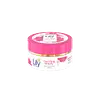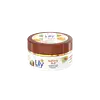What's inside
What's inside
 Key Ingredients
Key Ingredients

 Benefits
Benefits

 Concerns
Concerns

 Ingredients Side-by-side
Ingredients Side-by-side

Water
Skin ConditioningCetyl Alcohol
EmollientCeteth-25
CleansingStearic Acid
CleansingNiacinamide
SmoothingCetearyl Alcohol
EmollientPalmitic Acid
EmollientTitanium Dioxide
Cosmetic ColorantAluminum Hydroxide
EmollientDimethicone
EmollientHydrogen
AntioxidantHydrogen Dimethicone
Cyclopentasiloxane
EmollientEthylhexyl Methoxycinnamate
UV AbsorberOctocrylene
UV AbsorberButyl Methoxydibenzoylmethane
UV AbsorberParaffinum Liquidum
EmollientGlycerin
HumectantGlycol Stearate
EmollientPhenoxyethanol
PreservativeSodium Ascorbyl Phosphate
AntioxidantParfum
MaskingPEG-150 Distearate
EmulsifyingDisodium EDTA
Undecylenoyl Phenylalanine
Skin ConditioningSodium PCA
HumectantSodium Polyaspartate
HumectantButylene Glycol
HumectantBetaine
HumectantZinc PCA
HumectantSodium Citrate
BufferingArginine
MaskingSerine
MaskingLysine Hcl
Skin ConditioningGlutamic Acid
HumectantTocopheryl Acetate
AntioxidantAcrylates/C10-30 Alkyl Acrylate Crosspolymer
Emulsion StabilisingCitrus Limon Fruit Extract
MaskingWater, Cetyl Alcohol, Ceteth-25, Stearic Acid, Niacinamide, Cetearyl Alcohol, Palmitic Acid, Titanium Dioxide, Aluminum Hydroxide, Dimethicone, Hydrogen, Hydrogen Dimethicone, Cyclopentasiloxane, Ethylhexyl Methoxycinnamate, Octocrylene, Butyl Methoxydibenzoylmethane, Paraffinum Liquidum, Glycerin, Glycol Stearate, Phenoxyethanol, Sodium Ascorbyl Phosphate, Parfum, PEG-150 Distearate, Disodium EDTA, Undecylenoyl Phenylalanine, Sodium PCA, Sodium Polyaspartate, Butylene Glycol, Betaine, Zinc PCA, Sodium Citrate, Arginine, Serine, Lysine Hcl, Glutamic Acid, Tocopheryl Acetate, Acrylates/C10-30 Alkyl Acrylate Crosspolymer, Citrus Limon Fruit Extract
Water
Skin ConditioningParaffinum Liquidum
EmollientCetyl Alcohol
EmollientHelianthus Annuus Seed Oil
EmollientSodium PCA
HumectantGlycerin
HumectantStearyl Alcohol
EmollientCeteareth-25
CleansingGlyceryl Stearate
EmollientPentylene Glycol
Skin ConditioningFructose
HumectantUrea
BufferingMaltose
MaskingSodium Lactate
BufferingTrehalose
HumectantAllantoin
Skin ConditioningSodium Hyaluronate
HumectantGlucose
HumectantSodium Polyaspartate
HumectantButylene Glycol
HumectantBetaine
HumectantZinc PCA
HumectantArginine
MaskingSerine
MaskingLysine Hcl
Skin ConditioningGlutamic Acid
HumectantPhenoxyethanol
PreservativeButyrospermum Parkii Butter
Skin ConditioningCaprylic/Capric/Succinic Triglyceride
EmollientGlyceryl Isostearate
EmollientPrunus Amygdalus Dulcis Oil
Skin ConditioningPanthenol
Skin ConditioningTocopherol
AntioxidantParfum
MaskingWater, Paraffinum Liquidum, Cetyl Alcohol, Helianthus Annuus Seed Oil, Sodium PCA, Glycerin, Stearyl Alcohol, Ceteareth-25, Glyceryl Stearate, Pentylene Glycol, Fructose, Urea, Maltose, Sodium Lactate, Trehalose, Allantoin, Sodium Hyaluronate, Glucose, Sodium Polyaspartate, Butylene Glycol, Betaine, Zinc PCA, Arginine, Serine, Lysine Hcl, Glutamic Acid, Phenoxyethanol, Butyrospermum Parkii Butter, Caprylic/Capric/Succinic Triglyceride, Glyceryl Isostearate, Prunus Amygdalus Dulcis Oil, Panthenol, Tocopherol, Parfum
Ingredients Explained
These ingredients are found in both products.
Ingredients higher up in an ingredient list are typically present in a larger amount.
Arginine is an amino acid that is important for human development. Your body uses is it to produce hair keratin and skin collagen.
As a cosmetic ingredient, Arginine has antioxidant properties and can also help repair damaged skin. This ingredient is derived either synthetically or from animals.
Arginine isn't fungal acne safe when used in the presence of other lipids (fats, fatty acids, oils, esters, etc). Oils and fats occur naturally within the skin, so take caution when using Arginine if you're prone to fungal acne.
Learn more about ArginineBetaine is a common humectant (a substance that promotes retention of moisture). It's known to be gentle on the skin and can help balance hydration.
This ingredient is best for improving hydration and soothing irritated skin. Studies also show it helps even out skin tone.
Fun fact: Betaine is naturally created in the skin and body. The kind found within cosmetic products can be either plant-derived or synthetic.
Another name for betaine is trimethylglycine.
Learn more about BetaineButylene Glycol (or BG) is used within cosmetic products for a few different reasons:
Overall, Butylene Glycol is a safe and well-rounded ingredient that works well with other ingredients.
Though this ingredient works well with most skin types, some people with sensitive skin may experience a reaction such as allergic rashes, closed comedones, or itchiness.
Learn more about Butylene GlycolCetyl Alcohol is a fatty alcohol. Fatty Alcohols are most often used as an emollient or to thicken a product.
Its main roles are:
Though it has "alcohol" in the name, it is not related to denatured alcohol or ethyl alcohol.
The FDA allows products labeled "alcohol-free" to have fatty alcohols.
Learn more about Cetyl AlcoholGlutamic Acid is an amino acid that is found in all living organisms. Our bodies use this to help nerve cells in the brain communicate with other cells.
In cosmetics, glutamic acid is a famous humectant. It draws water from the air to your skin, keeping your skin hydrated (like hyaluronic acid).
An in-vitro study from 2024 found glutamic acid to play a role in inhibiting inflammation and thus a potential skin-soothing ingredient.
Other studies show it to be have potential wound healing, skin barrier repair, and hair growth properties.
Glutamic acid has poor solubility in water and other solvents.
Learn more about Glutamic AcidGlycerin is already naturally found in your skin. It helps moisturize and protect your skin.
A study from 2016 found glycerin to be more effective as a humectant than AHAs and hyaluronic acid.
As a humectant, it helps the skin stay hydrated by pulling moisture to your skin. The low molecular weight of glycerin allows it to pull moisture into the deeper layers of your skin.
Hydrated skin improves your skin barrier; Your skin barrier helps protect against irritants and bacteria.
Glycerin has also been found to have antimicrobial and antiviral properties. Due to these properties, glycerin is often used in wound and burn treatments.
In cosmetics, glycerin is usually derived from plants such as soybean or palm. However, it can also be sourced from animals, such as tallow or animal fat.
This ingredient is organic, colorless, odorless, and non-toxic.
Glycerin is the name for this ingredient in American English. British English uses Glycerol/Glycerine.
Learn more about GlycerinLysine HCl is an alpha amino acid salt.
Our skin uses amino acids as a precursor for building protein, and therefore keratins, collagen and elastin.
Paraffinum Liquidum is also known as liquid paraffin. It is a type of highly refined mineral oil.
Like other oils, Paraffinum Liquidum has emollient properties. Emollients help soothe and soften the skin. By creating a barrier to trap moisture within, emollients help keep your skin hydrated.
Paraffinum Liquidum does not irritate the skin and is non-comedogenic.
Learn more about Paraffinum LiquidumParfum is a catch-all term for an ingredient or more that is used to give a scent to products.
Also called "fragrance", this ingredient can be a blend of hundreds of chemicals or plant oils. This means every product with "fragrance" or "parfum" in the ingredients list is a different mixture.
For instance, Habanolide is a proprietary trade name for a specific aroma chemical. When used as a fragrance ingredient in cosmetics, most aroma chemicals fall under the broad labeling category of “FRAGRANCE” or “PARFUM” according to EU and US regulations.
The term 'parfum' or 'fragrance' is not regulated in many countries. In many cases, it is up to the brand to define this term.
For instance, many brands choose to label themselves as "fragrance-free" because they are not using synthetic fragrances. However, their products may still contain ingredients such as essential oils that are considered a fragrance by INCI standards.
One example is Calendula flower extract. Calendula is an essential oil that still imparts a scent or 'fragrance'.
Depending on the blend, the ingredients in the mixture can cause allergies and sensitivities on the skin. Some ingredients that are known EU allergens include linalool and citronellol.
Parfum can also be used to mask or cover an unpleasant scent.
The bottom line is: not all fragrances/parfum/ingredients are created equally. If you are worried about fragrances, we recommend taking a closer look at an ingredient. And of course, we always recommend speaking with a professional.
Learn more about ParfumPhenoxyethanol is a preservative that has germicide, antimicrobial, and aromatic properties. Studies show that phenoxyethanol can prevent microbial growth. By itself, it has a scent that is similar to that of a rose.
It's often used in formulations along with Caprylyl Glycol to preserve the shelf life of products.
Serine is an amino acid naturally found in our body. Our bodies use amino acids to create protein.
Amino-acids help give keep our skin hydrated. They play an important role in the skin barrier, which keeps the skin plump and firm.
Serine is a non-essential amino acid, meaning we don't need to obtain it from eating foods.
Learn more about SerineSodium PCA is the sodium salt of pyroglutamic acid. It is naturally occurring in our skin's natural moisturizing factors where it works to maintain hydration.
The PCA stands for pyrrolidone carboxylic acid, a natural amino acid derivative.
This ingredient has skin conditioning, anti-inflammatory, and humectant properties. Humectants help hydrate your skin by drawing moisture from the air. This helps keep your skin moisturized.
Learn more about Sodium PCAWe don't have a description for Sodium Polyaspartate yet.
Water. It's the most common cosmetic ingredient of all. You'll usually see it at the top of ingredient lists, meaning that it makes up the largest part of the product.
So why is it so popular? Water most often acts as a solvent - this means that it helps dissolve other ingredients into the formulation.
You'll also recognize water as that liquid we all need to stay alive. If you see this, drink a glass of water. Stay hydrated!
Learn more about WaterZinc PCA (or "zinc salt") differs slightly from zinc itself. PCA stands for pyrrolidone carboxylic acid. However, Zinc PCA comes from zinc.
It can help reduce redness, regulate sebum, and promote the general healing process of the skin.
Zinc PCA tends to be especially useful for those with oily, acne-prone skin. It's certainly an ingredient worth trying out!
Learn more about Zinc PCA